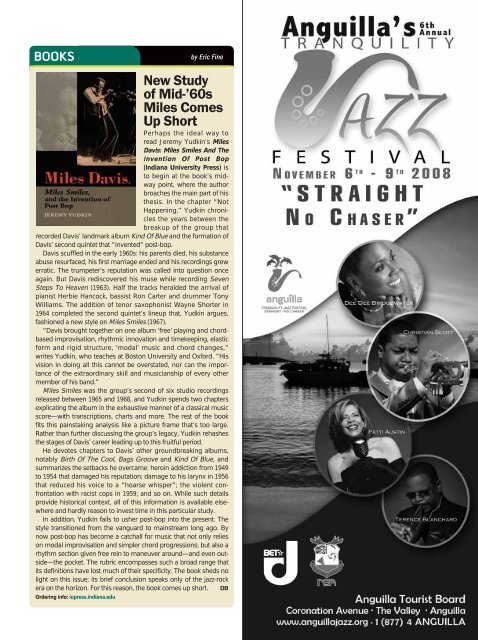Download - Downbeat
Download - Downbeat
Download - Downbeat
You also want an ePaper? Increase the reach of your titles
YUMPU automatically turns print PDFs into web optimized ePapers that Google loves.
BOOKS<br />
by Eric Fine<br />
New Study<br />
of Mid-’60s<br />
Miles Comes<br />
Up Short<br />
Perhaps the ideal way to<br />
read Jeremy Yudkin’s Miles<br />
Davis: Miles Smiles And The<br />
Invention Of Post Bop<br />
(Indiana University Press) is<br />
to begin at the book’s midway<br />
point, where the author<br />
broaches the main part of his<br />
thesis. In the chapter “Not<br />
Happening,” Yudkin chronicles<br />
the years between the<br />
breakup of the group that<br />
recorded Davis’ landmark album Kind Of Blue and the formation of<br />
Davis’ second quintet that “invented” post-bop.<br />
Davis scuffled in the early 1960s: his parents died, his substance<br />
abuse resurfaced, his first marriage ended and his recordings grew<br />
erratic. The trumpeter’s reputation was called into question once<br />
again. But Davis rediscovered his muse while recording Seven<br />
Steps To Heaven (1963). Half the tracks heralded the arrival of<br />
pianist Herbie Hancock, bassist Ron Carter and drummer Tony<br />
Williams. The addition of tenor saxophonist Wayne Shorter in<br />
1964 completed the second quintet’s lineup that, Yudkin argues,<br />
fashioned a new style on Miles Smiles (1967).<br />
“Davis brought together on one album ‘free’ playing and chordbased<br />
improvisation, rhythmic innovation and timekeeping, elastic<br />
form and rigid structure, ‘modal’ music and chord changes,”<br />
writes Yudkin, who teaches at Boston University and Oxford. “His<br />
vision in doing all this cannot be overstated, nor can the importance<br />
of the extraordinary skill and musicianship of every other<br />
member of his band.”<br />
Miles Smiles was the group’s second of six studio recordings<br />
released between 1965 and 1968, and Yudkin spends two chapters<br />
explicating the album in the exhaustive manner of a classical music<br />
score—with transcriptions, charts and more. The rest of the book<br />
fits this painstaking analysis like a picture frame that’s too large.<br />
Rather than further discussing the group’s legacy, Yudkin rehashes<br />
the stages of Davis’ career leading up to this fruitful period.<br />
He devotes chapters to Davis’ other groundbreaking albums,<br />
notably Birth Of The Cool, Bags Groove and Kind Of Blue, and<br />
summarizes the setbacks he overcame: heroin addiction from 1949<br />
to 1954 that damaged his reputation; damage to his larynx in 1956<br />
that reduced his voice to a “hoarse whisper”; the violent confrontation<br />
with racist cops in 1959; and so on. While such details<br />
provide historical context, all of this information is available elsewhere<br />
and hardly reason to invest time in this particular study.<br />
In addition, Yudkin fails to usher post-bop into the present. The<br />
style transitioned from the vanguard to mainstream long ago. By<br />
now post-bop has become a catchall for music that not only relies<br />
on modal improvisation and simpler chord progressions; but also a<br />
rhythm section given free rein to maneuver around—and even outside—the<br />
pocket. The rubric encompasses such a broad range that<br />
its definitions have lost much of their specificity. The book sheds no<br />
light on this issue; its brief conclusion speaks only of the jazz-rock<br />
era on the horizon. For this reason, the book comes up short. DB<br />
Ordering info: iupress.indiana.edu
















